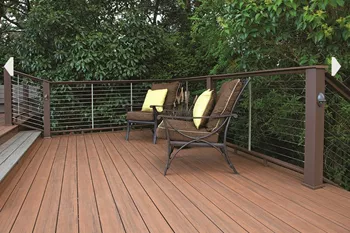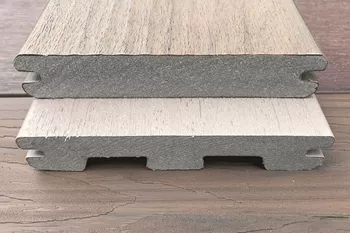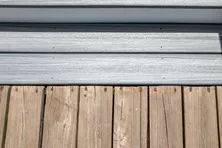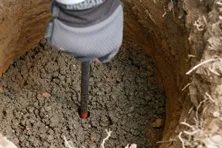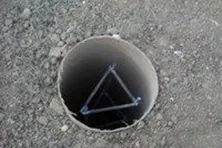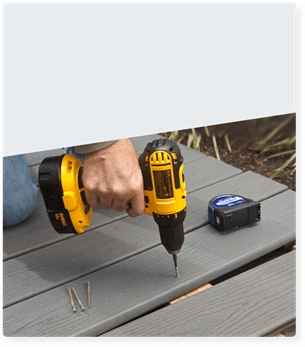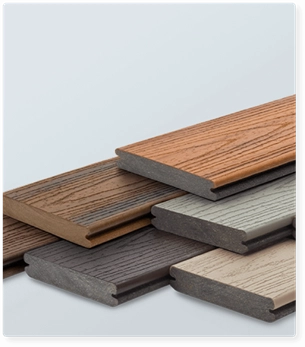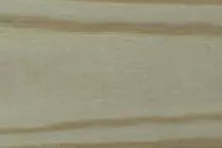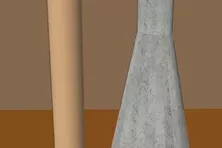Capped Composite Decking: What Is It?
Currently the king of the hill among high-end deck builders, capped composites are popular because they mimic the look of wood but require almost no maintenance. Capped composite deck boards are composed of a traditional composite wood / plastic core with a durable polymer protective shell. They come in a range of quality and price, so you’ll need to do some research to get the best deal. The advantage of capped composite decking is the PVC coating prevents mold and mildew from feeding on the organic fiber found in composite material.
Look for Durability
Some capped composites have a thick, hard shell that will hold up to heavy abuse, while others are less satisfactory. A reliable product should have a 25-year warranty against things like warping, stains, swelling, and fading. (You cannot expect a warranty against scratching, because no product can hold up against severe scratches.)
Good & Better
Many companies have two or more models of capped composites, to suit different budgets and tastes. At the low end, boards may be monocolored (though with a choice of 4 or 5 different colors) with an embossed wood grain. Mid-priced boards may have two or three colors to look more like wood. And top-end boards will have sophisticated patterns that use multiple colors; the patterns may repeat so seldom that you would have a difficult time seeing any repeats. Durability and fade resistance may be the same for all three levels, or the higher-end boards may be better quality.
Composite Cores
Capped boards with composite cores are more environmentally friendly because they are mostly made of recycled products. The ratio of plastic to wood flour is usually about 50/50.
Check out the capped composite decking options on Trex to learn more.
Composite vs Wood
Composite and wood decking differ in terms of maintenance, costs, labor, and lifetime value. Compare composite vs wood decking at Decks.com.
The Ultimate Guide to Composite Decking Profiles
Jump into this comprehensive guide to discover the best composite decking profiles. We reveal the secrets behind solid, scalloped, grooved, and hollow profiles, detailing their differences in purpose, design, size, material availability, and warranty.
Endeck
Endeck PVC decking is manufactured by Enduris Extrusions in Jacksonville, FL.
Cutting a Concrete Pad
Learn how to use a concrete saw to cut a hole in a patio slab to install a deck footing.
How to Install & Build Deck Footings
Learn how to install concrete footings to properly support your deck. Watch our step-by-step foundations video.
Do I need to use rebar?
Our inspector discusses using steel rebar for deck footings.
More Helpful Resources
Explore Articles by Topic

Footings
Information related to installing frost footings for decks

Framing
Learn structural framing methods

Decking
Learn about wood and composite decking materials

Stairs
An in-depth look at the complex issue of how to build stairs

Railings
How to install guardrails and handrails to meet IRC code

Features
An overview on water drainage, benches, planters and lights

Design
The basics of deck design

Planning
Learn about permits and working with contractors

Porches & Patios
Build a covered deck to enjoy all seasons

Ledger
Proper attachment techniques

Care
Maintain your deck to maintain your investment

Materials
An overview on water drainage, benches, planters and lights
Is Trex Decking Worth the Investment? Expert Insights and Reviews
Discover why Trex decking is worth the investment. Learn about its durability, low maintenance, eco-friendliness, and the long-term value it adds to your home.
Pressure Treated Wood: Types, Grading Standards & More
Wondering if pressure treated wood is right for your project? Learn more about the different types of pressure treated lumber as well as how long they last at Decks.com.
Composite Decking Prices
Composite decking ranges in price from $2 to $6 per linear foot. Compare brands and costs with our composite decking pricing chart at Decks.com.
How many footings do I need?
Learn how to determine the number of footings and support posts you need for your deck when designing your deck frame.
Monolithic Pier
Compare the pros and cons of installing a solid concrete deck footing using a cardboard tube or engineered forms.
How to Install & Build Deck Footings
Learn how to install concrete footings to properly support your deck. Watch our step-by-step foundations video.
Explore Articles by Topic

Footings
Information related to installing frost footings for decks

Framing
Learn structural framing methods

Decking
Learn about wood and composite decking materials

Stairs
An in-depth look at the complex issue of how to build stairs

Railings
How to install guardrails and handrails to meet IRC code

Features
An overview on water drainage, benches, planters and lights

Design
The basics of deck design

Planning
Learn about permits and working with contractors

Porches & Patios
Build a covered deck to enjoy all seasons

Ledger
Proper attachment techniques

Care
Maintain your deck to maintain your investment

Materials
An overview on water drainage, benches, planters and lights




